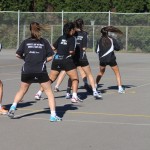 Lee-Anne Taylor knows what it’s like to injure her knees through playing netball so when it came to following a research interest she looked for ways to help prevent other netball players from doing the same. She also knew the statistics. Accident Compensation Commission data shows that the most common injuries for female netball players are knee and ankle injuries, with 4383 new claims made by 15 to 19-year-olds between July 2013 and June 2014. These and the 5880 ongoing claims had an associated cost that year of more than $8.37 million.
Lee-Anne Taylor knows what it’s like to injure her knees through playing netball so when it came to following a research interest she looked for ways to help prevent other netball players from doing the same. She also knew the statistics. Accident Compensation Commission data shows that the most common injuries for female netball players are knee and ankle injuries, with 4383 new claims made by 15 to 19-year-olds between July 2013 and June 2014. These and the 5880 ongoing claims had an associated cost that year of more than $8.37 million.
Because of their anatomy, young women are two to six times more likely than men to rupture their anterior cruciate ligament (ACL), the most common and debilitating knee injury in netball. Many who suffer ACL damage will show signs of arthritis ten years later. Knowing that young netballers’ injuries are mostly caused by poor landing technique which could be improved with targeted exercise, Lee-Anne, in her role as coach of the under-17s Hawke’s Bay netball team, trialled a warm-up protocol that was quite different from those traditionally used. Based on the ‘Prevent Injury and Enhance Performance Program’, reportedly successful in reducing knee injury rates in young female football players, the protocol involved trunk and lower limb strengthening, aerobic activity, jumping and landing techniques, agility and netball specific drills. Lee-Anne’s intention was to have her players adopt good landing technique based on sound biomechanical principals and to develop the strength and conditioning needed to help prevent injuries from occurring. This she achieved, with only one ankle injury sustained in her team throughout the trial season.
Lee-Anne presented the results of this trial protocol at the Physiotherapy New Zealand Conference in Auckland in September 2014. This led to the development of an injury prevention collaboration between Netball New Zealand, orthopaedic specialists, sports medicine practitioners and several physiotherapists.
With that collaborative project well underway Lee-Anne turned her attention to pre-season conditioning. A six-week pre-season conditioning programme found by other researchers to be effective in improving athletic performance and reducing injuries has been developed for 13 to 19-year-old netball players in the Netball Central Zone. This is the second largest zone in New Zealand in terms of adolescent netball players and therefore an excellent location for Lee-Anne to trial another injury prevention strategy.
Lee-Anne Taylor
Principal Lecturer
Health and Sport Science
e ltaylor@eit.ac.nz
